The Mitigating Efficacy of Multi-Functional Storage Spaces in Alleviating Urban Floods across Diverse Rainfall Scenarios
Abstract
1. Introduction
2. Materials and Methods
2.1. Study Area and Data
2.2. SWMM/LISFLOOD-FP Coupled Model
2.3. Evaluation of Model Accuracy
2.4. Multi-Functional Storage Space
2.5. Setting of Scenarios
2.5.1. Setting of Rainfall Scenarios
2.5.2. Setting of Project Scenarios
3. Results
3.1. Calibration and Verification of Model Parameters
3.2. Analysis of the Existing Situation of the Drainage System
3.3. Influence of Rainfall Intensity on LID and MFS Practices
3.3.1. Impact of Rainfall Intensity on LID and MFS Practices
3.3.2. Impact of Rainfall Peak Coefficient on LID and MFS Practices
3.3.3. Changes in LID and MFS Characteristics under Different Rainfall Scenarios
4. Discussion
5. Conclusions
Author Contributions
Funding
Institutional Review Board Statement
Informed Consent Statement
Data Availability Statement
Conflicts of Interest
References
- Tellman, B.; Sullivan, J.A.; Kuhn, C.; Kettner, A.J.; Doyle, C.S.; Brakenridge, G.R.; Erickson, T.A.; Slayback, D.A. Satellite Imaging Reveals Increased Proportion of Population Exposed to Floods. Nature 2021, 596, 80–86. [Google Scholar] [CrossRef]
- Rentschler, J.; Avner, P.; Marconcini, M.; Su, R.; Strano, E.; Vousdoukas, M.; Hallegatte, S. Global Evidence of Rapid Urban Growth in Flood Zones since 1985. Nature 2023, 622, 87–92. [Google Scholar] [CrossRef]
- Arnell, N.W.; Gosling, S.N. The impacts of climate change on river flood risk at the global scale. Clim. Chang. 2016, 134, 387–401. [Google Scholar] [CrossRef]
- Kam, P.M.; Aznar-Siguan, G.; Schewe, J.; Milano, L.; Ginnetti, J.; Willner, S.; McCaughey, J.W.; Bresch, D.N. Global Warming and Population Change Both Heighten Future Risk of Human Displacement Due to River Floods. Environ. Res. Lett. 2021, 16, 044026. [Google Scholar] [CrossRef]
- Sampson, C.C.; Smith, A.M.; Bates, P.B.; Neal, J.C.; Alfieri, L.; Freer, J.E. A high-resolution global flood hazard model. Water Resour. Res. 2015, 51, 7358–7381. [Google Scholar] [CrossRef]
- Lyu, H.M.; Sun, W.J.; Shen, S.L.; Arulrajah, A. Flood risk assessment in metro systems of mega-cities using a GIS-based modeling approach. Sci. Total Environ. 2018, 626, 1012–1025. [Google Scholar] [CrossRef]
- Li, S.; Wang, Z.; Wu, X.; Zeng, Z.; Shen, P.; Lai, C. A novel spatial optimization approach for the cost-effectiveness improvement of LID practices based on SWMM-FTC. J. Environ. Manag. 2022, 307, 114574. [Google Scholar] [CrossRef]
- Jiang, Y.; Zevenbergen, C.; Ma, Y.C. Urban pluvial flooding and stormwater management: A contemporary review of China’s challenges and “sponge cities” strategy. Environ. Sci. Policy 2017, 80, 132–143. [Google Scholar] [CrossRef]
- Lai, C.; Chen, X.; Wang, Z.; Yu, H.; Bai, X. Flood Risk Assessment and Regionalization from Past and Future Perspectives at Basin Scale. Risk Anal. 2020, 40, 1399–1417. [Google Scholar] [CrossRef]
- Lai, C.; Sun, H.; Wu, X.; Li, J.; Wang, Z.; Tong, H.; Feng, J. Water Availability May Not Constrain Vegetation Growth in Northern Hemisphere. Agric. Water Manag. 2024, 291, 108649. [Google Scholar] [CrossRef]
- Güneralp, B.; Güneralp, I.; Liu, Y. Changing global patterns of urban exposure to flood and drought hazards. Glob. Envron. Chang. 2015, 31, 217–225. [Google Scholar] [CrossRef]
- Scalise, C.; Fitzpatrick, K. Chicago deep tunnel design and construction. In Structures Congress 2012; American Society of Civil Engineers: San Francisco, CA, USA, 2012; pp. 1485–1495. [Google Scholar]
- Butler, D.; Digman, C.J.; Makropoulos, C.; Davies, J.W. Urban Drainage, 4th ed.; CRC Press: Boca Raton, MA, USA, 2018; ISBN 978-1-351-17430-5. [Google Scholar]
- Sohn, W.; Brody, S.D.; Kim, J.-H.; Li, M.-H. How Effective Are Drainage Systems in Mitigating Flood Losses? Cities 2020, 107, 102917. [Google Scholar] [CrossRef]
- Junk, W.J.; An, S.; Finlayson, C.M.; Gopal, B.; Květ, J.; Mitchell, S.A.; Mitsch, W.J.; Robarts, R.D. Current State of Knowledge Regarding the World’s Wetlands and Their Future under Global Climate Change: A Synthesis. Aquat. Sci. 2013, 75, 151–167. [Google Scholar] [CrossRef]
- Ashley, R.; Lundy, L.; Ward, S.; Shaffer, P.; Walker, L.; Morgan, C.; Saul, A.; Wong, T.; Moore, S. Water-Sensitive Urban Design: Opportunities for the UK. Proc. Inst. Civ. Eng.-Munic. Eng. 2013, 166, 65–76. [Google Scholar] [CrossRef]
- Ice, G. History of Innovative Best Management Practice Development and Its Role in Addressing Water Quality Limited Waterbodies. J. Environ. Eng. 2004, 130, 684–689. [Google Scholar] [CrossRef]
- Dietz, M.E. Low Impact Development Practices: A Review of Current Research and Recommendations for Future Directions. Water Air Soil Pollut. 2007, 186, 351–363. [Google Scholar] [CrossRef]
- Scholes, L.; Revitt, D.M.; Ellis, J.B. A Systematic Approach for the Comparative Assessment of Stormwater Pollutant Removal Potentials. J. Environ. Manag. 2008, 88, 467–478. [Google Scholar] [CrossRef]
- Fletcher, T.D.; Shuster, W.; Hunt, W.F.; Ashley, R.; Butler, D.; Arthur, S.; Trowsdale, S.; Barraud, S.; Semadeni-Davies, A.; Bertrand-Krajewski, J.-L.; et al. SUDS, LID, BMPs, WSUD and More—The Evolution and Application of Terminology Surrounding Urban Drainage. Urban Water J. 2015, 12, 525–542. [Google Scholar] [CrossRef]
- Hernes, R.R.; Gragne, A.S.; Abdalla, E.M.H.; Braskerud, B.C.; Alfredsen, K.; Muthanna, T.M. Assessing the Effects of Four SUDS Scenarios on Combined Sewer Overflows in Oslo, Norway: Evaluating the Low-Impact Development Module of the Mike Urban Model. Hydrol. Res. 2020, 51, 1437–1454. [Google Scholar] [CrossRef]
- Muttil, N.; Nasrin, T.; Sharma, A.K. Impacts of Extreme Rainfalls on Sewer Overflows and WSUD-Based Mitigation Strategies: A Review. Water 2023, 15, 429. [Google Scholar] [CrossRef]
- Eckart, K.; McPhee, Z.; Bolisetti, T. Performance and Implementation of Low Impact Development—A Review. Sci. Total Environ. 2017, 607–608, 413–432. [Google Scholar] [CrossRef]
- Sui, X.; van de Ven, F.H.M. The Influence of Low Impact Development (LID) on Basin Runoff in a Half-Urbanized Catchment: A Case Study in San Antonio, Texas. J. Hydrol. 2023, 616, 128793. [Google Scholar] [CrossRef]
- Cao, Q.; Cao, J.; Xu, R. Optimizing Low Impact Development for Stormwater Runoff Treatment: A Case Study in Yixing, China. Water 2023, 15, 989. [Google Scholar] [CrossRef]
- Carter, T.L.; Rasmussen, T.C. Hydrologic Behavior of Vegetated Roofs1. JAWRA J. Am. Water Resour. Assoc. 2006, 42, 1261–1274. [Google Scholar] [CrossRef]
- Shuangcheng, T.; Wan, L.U.O.; Zhonghua, J.I.A.; Shan, L.I.; Yan, W.U.; Meng, Z. Effect of rain gardens on storm runoff reduction. Adv. Water Sci. 2015, 26, 787–794. [Google Scholar] [CrossRef]
- Vineyard, D.; Ingwersen, W.W.; Hawkins, T.R.; Xue, X.; Demeke, B.; Shuster, W. Comparing Green and Grey Infrastructure Using Life Cycle Cost and Environmental Impact: A Rain Garden Case Study in Cincinnati, OH. JAWRA J. Am. Water Resour. Assoc. 2015, 51, 1342–1360. [Google Scholar] [CrossRef]
- Hettiarachchi, S.; Wasko, C.; Sharma, A. Rethinking Urban Storm Water Management through Resilience—The Case for Using Green Infrastructure in Our Warming World. Cities 2022, 128, 103789. [Google Scholar] [CrossRef]
- Mulligan, J.; Bukachi, V.; Clause, J.C.; Jewell, R.; Kirimi, F.; Odbert, C. Hybrid Infrastructures, Hybrid Governance: New Evidence from Nairobi (Kenya) on Green-Blue-Grey Infrastructure in Informal Settlements. Anthropocene 2020, 29, 100227. [Google Scholar] [CrossRef]
- Alves, A.; Gersonius, B.; Kapelan, Z.; Vojinovic, Z.; Sanchez, A. Assessing the Co-Benefits of Green-Blue-Grey Infrastructure for Sustainable Urban Flood Risk Management. J. Environ. Manag. 2019, 239, 244–254. [Google Scholar] [CrossRef]
- Bertilsson, L.; Wiklund, K.; de Moura Tebaldi, I.; Rezende, O.M.; Veról, A.P.; Miguez, M.G. Urban Flood Resilience—A Multi-Criteria Index to Integrate Flood Resilience into Urban Planning. J. Hydrol. 2019, 573, 970–982. [Google Scholar] [CrossRef]
- McClymont, K.; Morrison, D.; Beevers, L.; Carmen, E. Flood Resilience: A Systematic Review. J. Environ. Plan. Manag. 2020, 63, 1151–1176. [Google Scholar] [CrossRef]
- Matos Silva, M.; Costa, J. Flood Adaptation Measures Applicable in the Design of Urban Public Spaces: Proposal for a Conceptual Framework. Water 2016, 8, 284. [Google Scholar] [CrossRef]
- Silva, M.M.; Costa, J.P. Urban Floods and Climate Change Adaptation: The Potential of Public Space Design When Accommodating Natural Processes. Water 2018, 10, 180. [Google Scholar] [CrossRef]
- Che, W.; Zhang, Y.; Li, J.Q.; Liu, H.; He, J.P.; Meng, G.H.; Wang, H.L. Multi-Functional Storage of Rainwater in Urban Area. Water Wastewater Eng. 2005, 31, 25–29. (In Chinese) [Google Scholar]
- Nie, R. A Study on Effects of Urban Space on Flood Mitigation—The Case of Tokyo. Urban Plan. Forum 2012, 6, 79–85. (In Chinese) [Google Scholar]
- Allen, J. Ambient Power: Berlin’s Potsdamer Platz and the Seductive Logic of Public Spaces. Urban Stud. 2006, 43, 441–455. [Google Scholar] [CrossRef]
- Urbanisten, D. Water Square Benthemplein in Rotterdam, the Netherlands. Landsc. Archit. Front. 2013, 1, 136–143. [Google Scholar]
- Ilgen, S.; Sengers, F.; Wardekker, A. City-To-City Learning for Urban Resilience: The Case of Water Squares in Rotterdam and Mexico City. Water 2019, 11, 983. [Google Scholar] [CrossRef]
- Wu, Y.; Liu, Y. Transforming Industrial Waterfronts into Inclusive Landscapes: A Project Method and Investigation of Landscape as a Medium for Sustainable Revitalization. Sustainability 2023, 15, 5060. [Google Scholar] [CrossRef]
- Xiaodan, L.; Yamaguchi, K. Kawasaki Issues and Strategies for Designing Flood Resilient Public Space to Achieve a Balance between Public Amenity and Stormwater Management Infrastructure. Urban Reg. Plan. Rev. 2023, 10, 197–223. [Google Scholar] [CrossRef]
- Galvin, M.; Maassen, A. In Nairobi, Residents Redesign Public Spaces to Build Flood Resilience. 2021. Available online: https://www.wri.org/nairobi-public-spaces-build-flood-resilience?utm_source=feedburner&utm_medium=feed&utm_campaign=Feed%3A+wri_news_and_views+%28WRI+Insights+Blog%2C+News%2C+and+Publications+%7C+World+Resources+Institute%29 (accessed on 25 October 2023).
- Wang, S.; Wang, X. Study on Landscape Ways of Rainwater Resource Utilization in Urban Public Space. Chin. Landsc. Archit. 2014, 30, 5–9. (In Chinese) [Google Scholar]
- Wang, Z.; Li, X.; Huang, R.; Tang, J. Strategy of Potential Rainwater Storage Space Exploration under the Background of Sponge City. Mod. Urban Res. 2016, 7, 23–28. (In Chinese) [Google Scholar]
- Jauhari Hildayanti, A. The Role of Public Spaces for Flood Management on the Mahakam Riverbank. 2021. Available online: https://dspace.uii.ac.id/handle/123456789/43587 (accessed on 21 March 2024).
- Liao, K.-H.; Le, T.A.; Nguyen, K.V. Urban Design Principles for Flood Resilience: Learning from the Ecological Wisdom of Living with Floods in the Vietnamese Mekong Delta. Landsc. Urban Plan. 2016, 155, 69–78. [Google Scholar] [CrossRef]
- Jiang, Q.; Zheng, B. Study on the Influence of Urban Stormwater Detention and Retention Space on Flood Disaster—Case Study of Flood Disaster in Changsha, 2017. J. Nat. Disasters 2018, 27, 29–38. (In Chinese) [Google Scholar]
- Yang, S.-Y.; Chen, W.-T.; Lin, C.-H.; Chang, L.-F.; Fang, W.-T.; Jhong, B.-C. Adaptation Strategy with Public Space for Pluvial Flood Risk Mitigation in a Densely Populated City: A Case Study in Huwei, Taiwan. J. Hydrol. Reg. Stud. 2023, 48, 101452. [Google Scholar] [CrossRef]
- Niazi, M.; Nietch, C.; Maghrebi, M.; Jackson, N.; Bennett, B.R.; Tryby, M.; Massoudieh, A. Storm Water Management Model: Performance Review and Gap Analysis. J. Sustain. Water Built Environ. 2017, 3, 04017002. [Google Scholar] [CrossRef] [PubMed]
- Arjenaki, M.O.; Sanayei, H.R.Z.; Heidarzadeh, H.; Mahabadi, N.A. Modeling and Investigating the Effect of the LID Methods on Collection Network of Urban Runoff Using the SWMM Model (Case Study: Shahrekord City). Model. Earth Syst. Environ. 2021, 7, 1–16. [Google Scholar] [CrossRef]
- Dell, T.; Razzaghmanesh, M.; Sharvelle, S.; Arabi, M. Development and Application of a SWMM-Based Simulation Model for Municipal Scale Hydrologic Assessments. Water 2021, 13, 1644. [Google Scholar] [CrossRef]
- Ma, B.; Wu, Z.; Hu, C.; Wang, H.; Xu, H.; Yan, D.; Soomro, S. Process-Oriented SWMM Real-Time Correction and Urban Flood Dynamic Simulation. J. Hydrol. 2022, 605, 127269. [Google Scholar] [CrossRef]
- Pushpalatha, R.; Perrin, C.; Moine, N.L.; Andréassian, V. A Review of Efficiency Criteria Suitable for Evaluating Low-Flow Simulations. J. Hydrol. 2012, 420–421, 171–182. [Google Scholar] [CrossRef]
- Yang, L.; Smith, J.A.; Baeck, M.L.; Zhang, Y. Flash Flooding in Small Urban Watersheds: Storm Event Hydrologic Response. Water Resour. Res. 2016, 52, 4571–4589. [Google Scholar] [CrossRef]
- Chen, Z.; Yin, L.; Chen, X.; Wei, S.; Zhu, Z. Research on the Characteristics of Urban Rainstorm Pattern in the Humid Area of Southern China: A Case Study of Guangzhou City. Int. J. Climatol. 2015, 35, 4370–4386. [Google Scholar] [CrossRef]
- He, S.; Wang, Z.; Wang, D.; Liao, W.; Wu, X.; Lai, C. Spatiotemporal Variability of Event-Based Rainstorm: The Perspective of Rainfall Pattern and Concentration. Int. J. Climatol. 2022, 42, 6258–6276. [Google Scholar] [CrossRef]
- Chen, P.; Wang, Z.; Zeng, Z.; Chen, X. Assessing influence of future urbanization on hydrological process in typical river basin. J. Hydroelectr. Eng. 2020, 39, 67–77. (In Chinese) [Google Scholar]
- Wang, Z.; Li, S.; Wu, X.; Lin, G.; Lai, C. Impact of Spatial Discretization Resolution on the Hydrological Performance of Layout Optimization of LID Practices. J. Hydrol. 2022, 612, 128113. [Google Scholar] [CrossRef]
- Hou, J.; Guo, K.; Wang, Z.; Jing, H.; Li, D. Numerical Simulation of Design Storm Pattern Effects on Urban Flood Inundation. Adv. Water Sci. 2017, 28, 820–828. (In Chinese) [Google Scholar]
- Liao, Y.; Wang, Z.; Chen, X.; Lai, C. Fast Simulation and Prediction of Urban Pluvial Floods Using a Deep Convolutional Neural Network Model. J. Hydrol. 2023, 624, 129945. [Google Scholar] [CrossRef]
- Wu, L.; Ma, D.; Wang, Z.; Zhang, J.; Zhang, B.; Li, J.; Liao, J.; Tong, J. A Deep CNN-Based Constitutive Model for Describing of Statics Characteristics of Rock Materials. Eng. Fract. Mech. 2023, 279, 109054. [Google Scholar] [CrossRef]
- Wu, L.; Tong, J.; Wang, Z.; Li, J.; Li, M.; Li, H.; Feng, Y. Post-Flood Disaster Damaged Houses Classification Based on Dual-View Image Fusion and Concentration-Based Attention Module. Sustain. Cities Soc. 2024, 103, 105234. [Google Scholar] [CrossRef]
- Qin, H.; Li, Z.; Fu, G. The Effects of Low Impact Development on Urban Flooding under Different Rainfall Characteristics. J. Environ. Manag. 2013, 129, 577–585. [Google Scholar] [CrossRef]
- Hu, M.; Zhang, X.; Li, Y.; Yang, H.; Tanaka, K. Flood Mitigation Performance of Low Impact Development Technologies under Different Storms for Retrofitting an Urbanized Area. J. Clean. Prod. 2019, 222, 373–380. [Google Scholar] [CrossRef]
- Xie, K.; He, Y.; Kim, J.-S.; Yoon, S.-K.; Liu, J.; Chen, H.; Lee, J.H.; Zhang, X.; Xu, C.-Y. Assessment of the Joint Impact of Rainfall Characteristics on Urban Flooding and Resilience Using the Copula Method. Water Resour. Manag. 2023, 37, 1765–1784. [Google Scholar] [CrossRef]
- Zhang, Q.; Wu, Z.; Zhang, H.; Dalla Fontana, G.; Tarolli, P. Identifying Dominant Factors of Waterlogging Events in Metropolitan Coastal Cities: The Case Study of Guangzhou, China. J. Environ. Manag. 2020, 271, 110951. [Google Scholar] [CrossRef] [PubMed]
- Qi, M.; Huang, H.; Liu, L.; Chen, X. Spatial Heterogeneity of Controlling Factors’ Impact on Urban Pluvial Flooding in Cincinnati, US. Appl. Geogr. 2020, 125, 102362. [Google Scholar] [CrossRef]
- Wang, Y.; Li, C.; Liu, M.; Cui, Q.; Wang, H.; Lv, J.; Li, B.; Xiong, Z.; Hu, Y. Spatial Characteristics and Driving Factors of Urban Flooding in Chinese Megacities. J. Hydrol. 2022, 613, 128464. [Google Scholar] [CrossRef]
- Zeng, Z.; Wang, Z.; Lai, C. Simulation Performance Evaluation and Uncertainty Analysis on a Coupled Inundation Model Combining SWMM and WCA2D. Int. J. Disaster Risk Sci. 2022, 13, 448–464. [Google Scholar] [CrossRef]
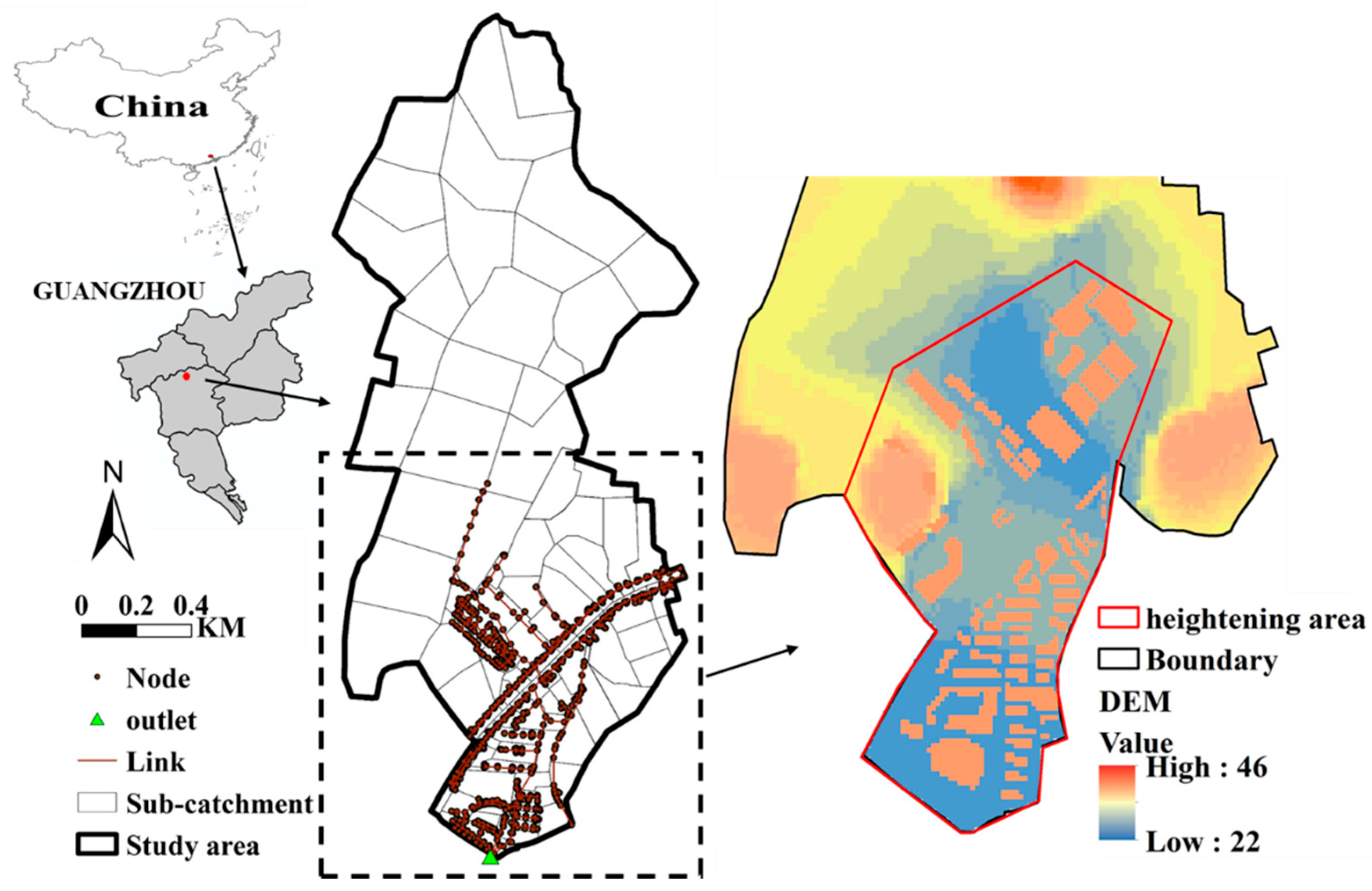

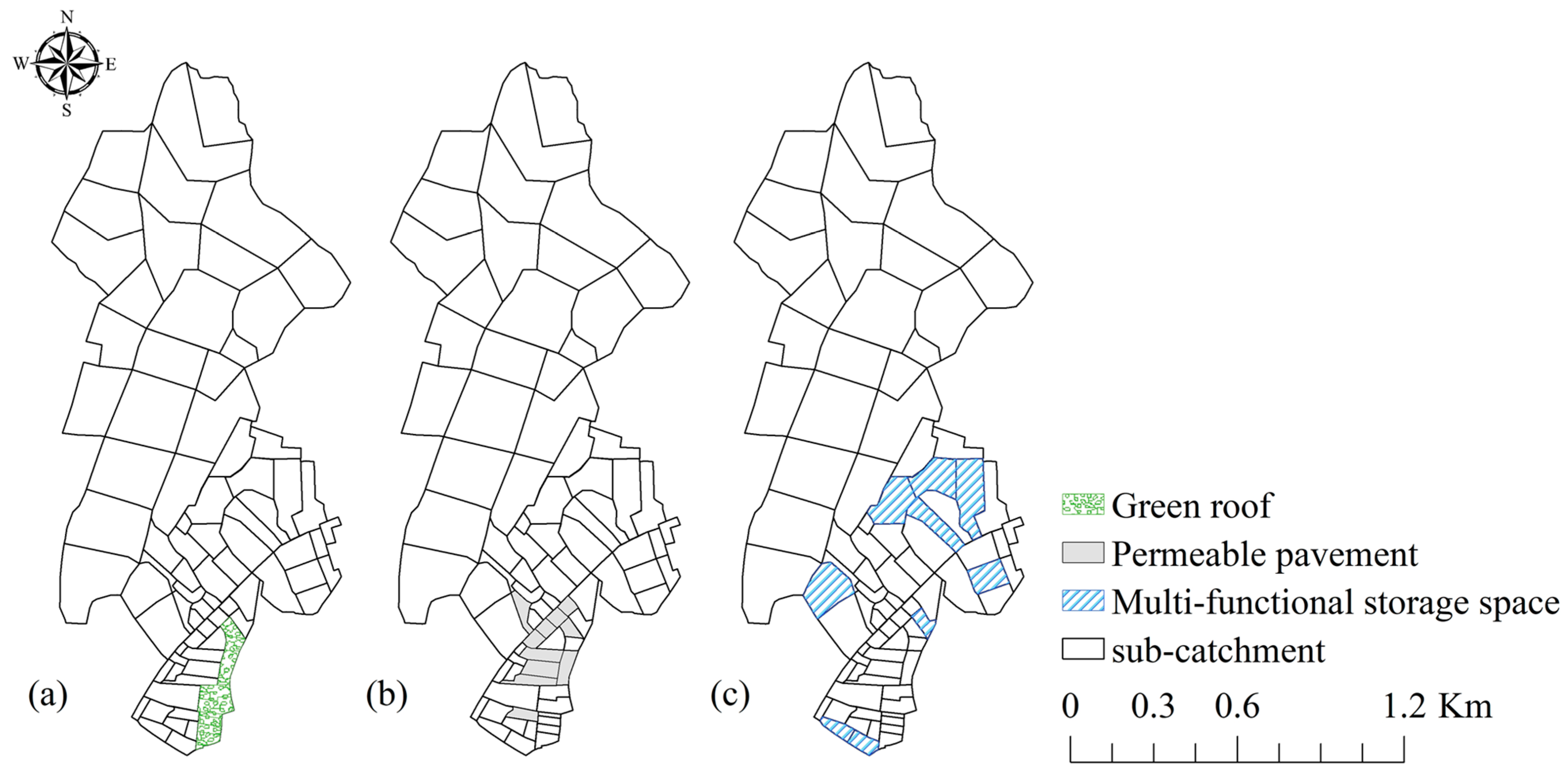

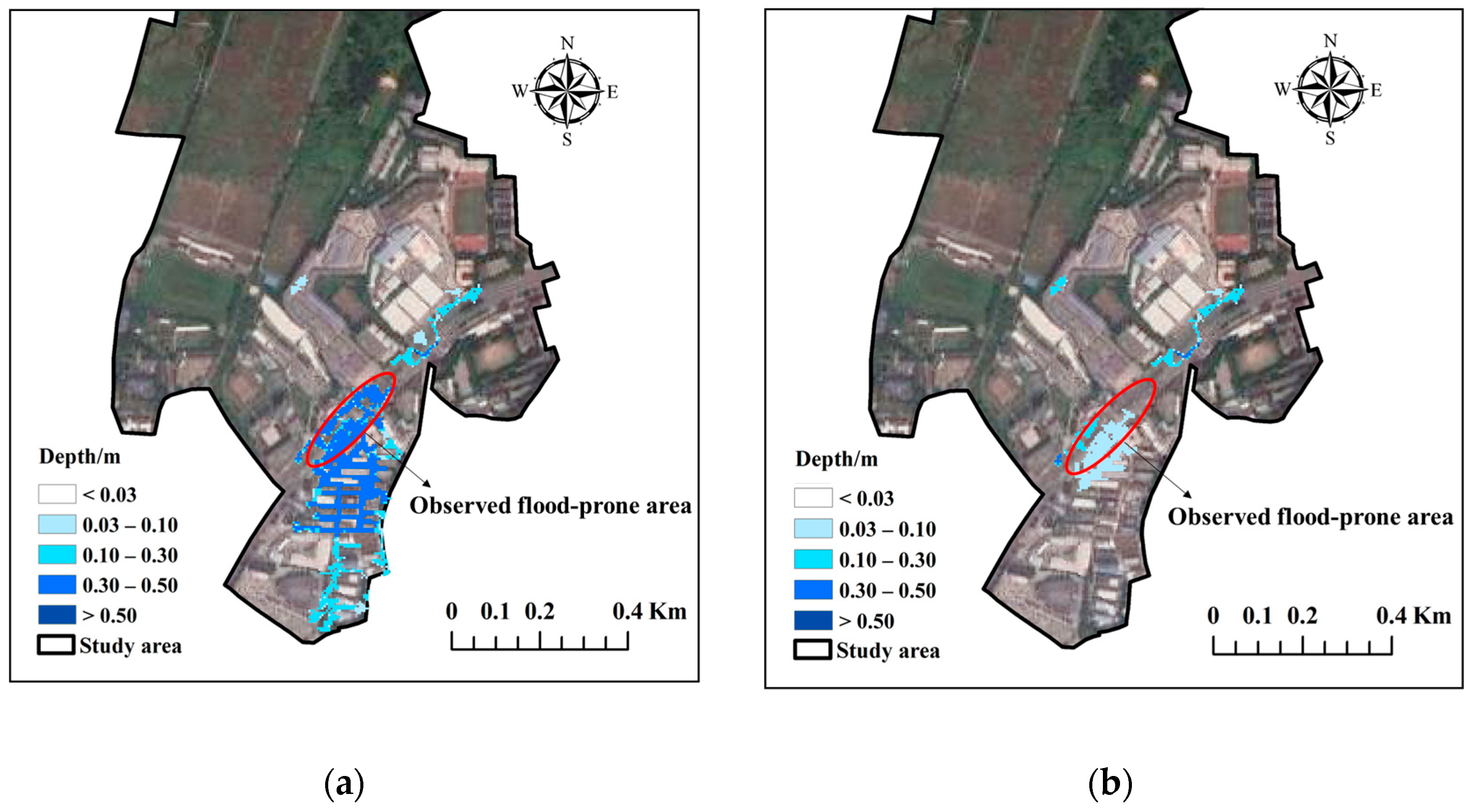

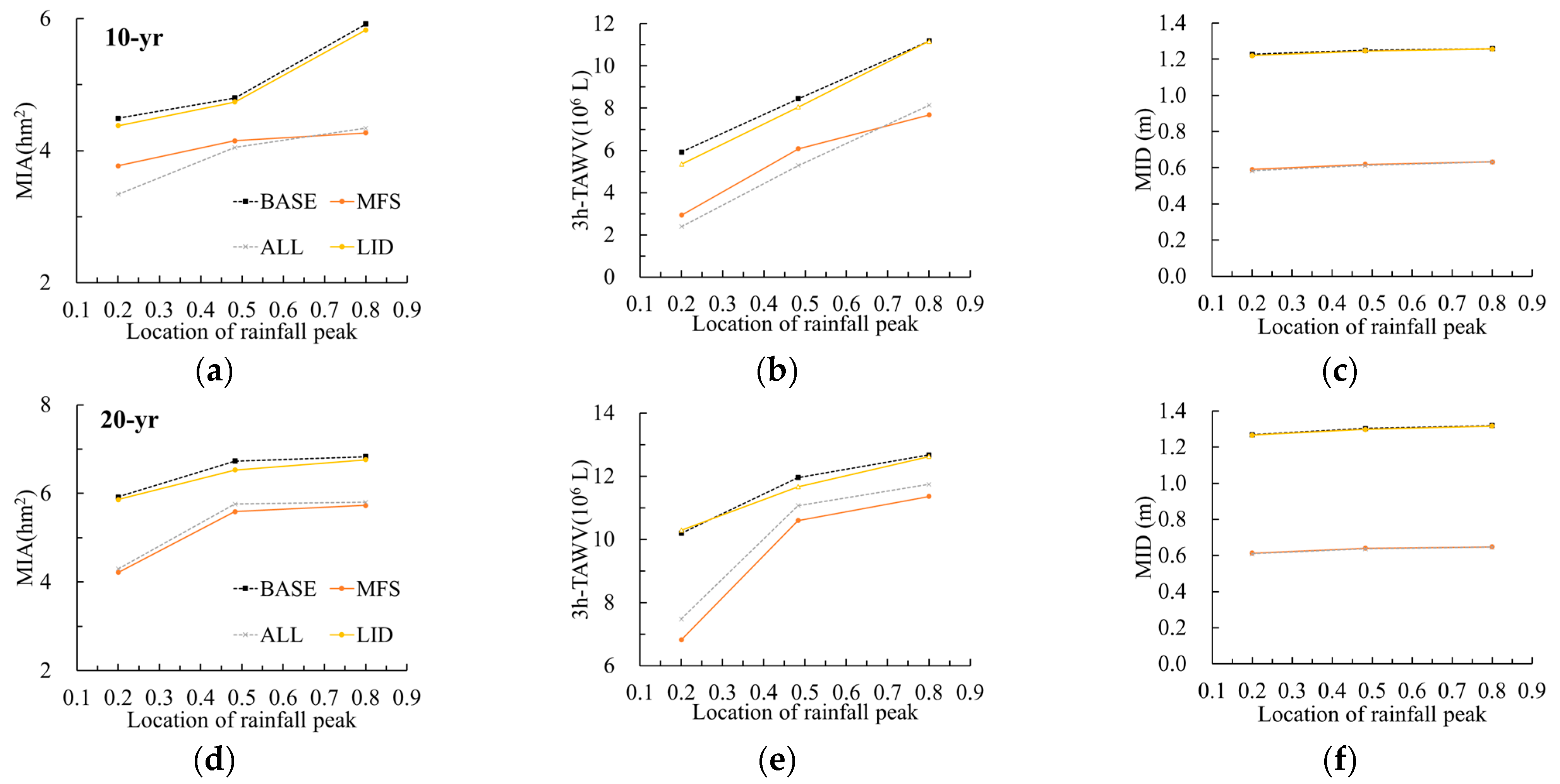
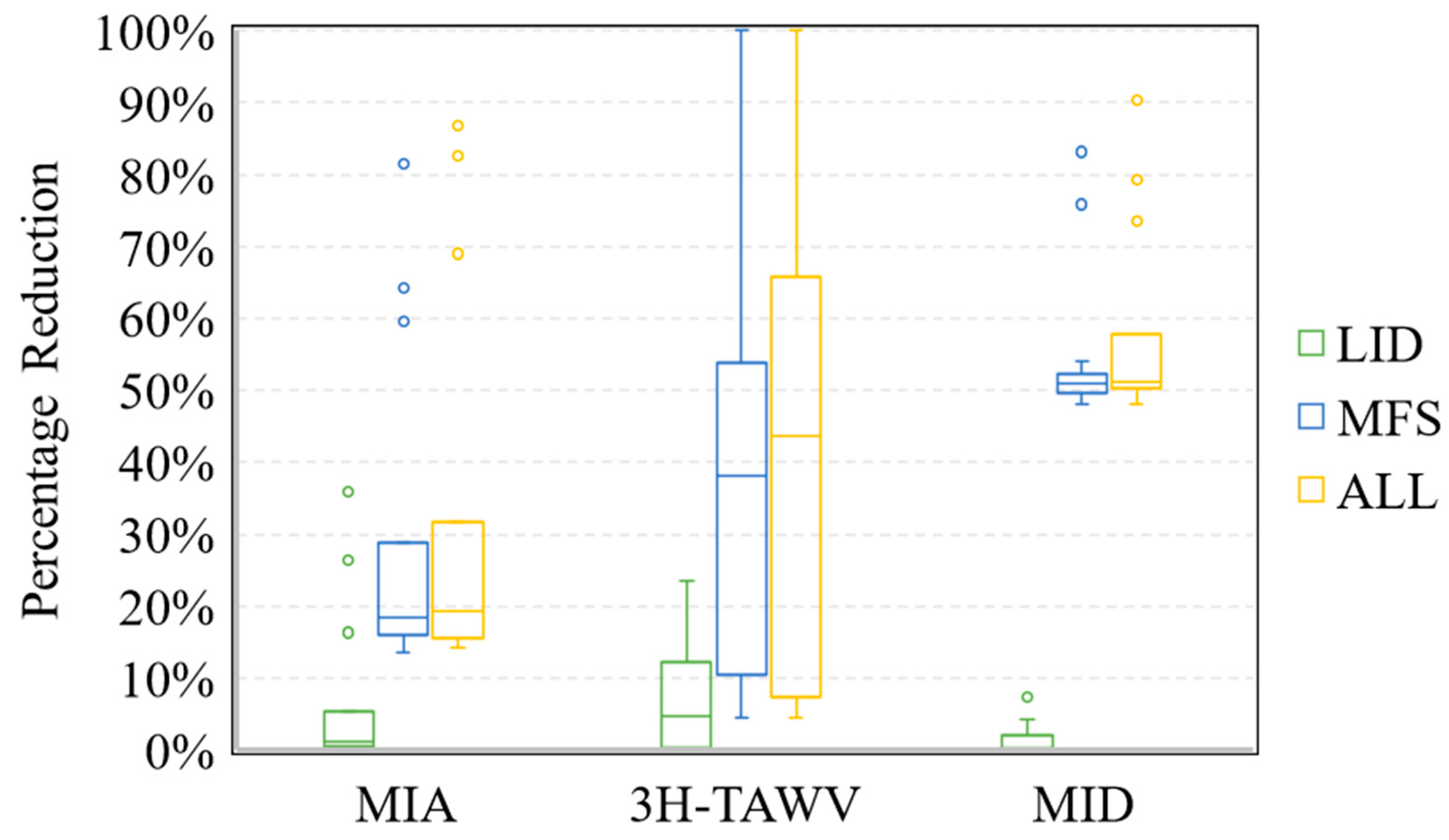
| Land-Use Type | Traffic Pavement | Building | Open Space | Study Area |
|---|---|---|---|---|
| Area/hm2 | 7.75 | 23.12 | 18.87 | 155.83 |
| Scenarios | Permeable pavement | Green roof | MFS | ALL |
| Layout area of facilities/hm2 | 2.35 | 0.59 | 4.39 | 7.32 |
| Facility layout ratio/% | 30.26 | 2.53 | 23.24 | 14.71 |
| Layer | Parameter | Unit | Traditional LID | Multi-Functional Storage Space | |
|---|---|---|---|---|---|
| Green Roof | Permeable Pavement | ||||
| Surface | Berm height | mm | 50 | 5 | 500 |
| Vegetative volume fraction | 0.15 | 0 | 0 | ||
| Surface roughness | 0.24 | 0.15 | 0.15 | ||
| Surface slope | 1 | 1 | 0 | ||
| Soil | Thickness | mm | 150 | - | - |
| Porosity | 0.5 | - | - | ||
| Field capacity | 0.1 | - | - | ||
| Wilting Point | 0.05 | - | - | ||
| Conductivity | mm/h | 30 | - | - | |
| Conductivity slope | 5 | - | - | ||
| Suction head | mm | 60 | - | - | |
| Pavement | Thickness | mm | - | 100 | - |
| Void ratio | - | 0.15 | - | ||
| Permeability | mm/h | - | 150 | - | |
| Storage | Thickness | mm | - | 300 | 3000 |
| Void ratio | - | 0.7 | 0.75 | ||
| Seepage rate | mm/h | - | 8 | 8 | |
| Storage Drain | Drain coefficient | - | 0.33 | 0.56 | |
| Drain exponent | - | 0.5 | 0.5 | ||
| Drain offset height | mm | - | 10 | 10 | |
| Drainage Mat | Thickness | mm | 50 | - | - |
| Void fraction | 0.5 | - | - | ||
| Roughness | 0.1 | - | - | ||
| Return Period | Maximum Inundation Area/hm2 | Total Accumulated Water Volume over 3 h/106 L | Maximum Inundation Depth/m | ||||||
|---|---|---|---|---|---|---|---|---|---|
| r = 0.2 | r = 0.48 | r = 0.8 | r = 0.2 | r = 0.48 | r = 0.8 | r = 0.2 | r = 0.48 | r = 0.8 | |
| 1-year (67.43 mm) | 0.92 | 1.59 | 1.90 | 0.51 | 0.82 | 1.00 | 0.532 | 0.579 | 0.612 |
| 5-year (92.55 mm) | 4.02 | 4.35 | 4.45 | 3.51 | 5.17 | 6.97 | 0.745 | 1.200 | 1.203 |
| 10-year (103.37 mm) | 4.49 | 4.80 | 5.92 | 5.92 | 8.45 | 11.18 | 1.227 | 1.250 | 1.258 |
| 20-year (114.19 mm) | 5.92 | 6.73 | 6.83 | 10.19 | 11.96 | 12.68 | 1.269 | 1.303 | 1.319 |
| 50-year (128.49 mm) | 7.32 | 7.82 | 7.97 | 12.13 | 13.41 | 14.49 | 1.322 | 1.349 | 1.380 |
| Return Period | Scenario | Maximum Inundation Area/hm2 | Total Accumulated Water Volume over 3 h/106 L | Maximum Inundation Depth/m | ||||||
|---|---|---|---|---|---|---|---|---|---|---|
| r = 0.2 | r = 0.48 | r = 0.8 | r = 0.2 | r = 0.48 | r = 0.8 | r = 0.2 | r = 0.48 | r = 0.8 | ||
| 1-year | Base | 0.92 | 1.59 | 1.90 | 0.51 | 0.82 | 1.00 | 0.532 | 0.579 | 0.612 |
| MFS | 0.17 | 0.57 | 0.77 | 0.00 | 0.03 | 0.11 | 0.090 | 0.140 | 0.282 | |
| ALL | 0.16 | 0.21 | 0.59 | 0.00 | 0.00 | 0.07 | 0.052 | 0.120 | 0.162 | |
| LID | 0.59 | 1.17 | 1.59 | 0.39 | 0.67 | 0.84 | 0.493 | 0.554 | 0.594 | |
| 5-year | Base | 4.02 | 4.35 | 4.45 | 3.51 | 5.17 | 6.97 | 0.745 | 1.200 | 1.203 |
| MFS | 3.21 | 3.62 | 3.77 | 1.62 | 2.99 | 4.31 | 0.551 | 0.591 | 0.609 | |
| ALL | 2.75 | 3.51 | 3.74 | 1.20 | 2.63 | 3.93 | 0.531 | 0.586 | 0.606 | |
| LID | 3.80 | 4.35 | 4.45 | 3.08 | 4.93 | 6.62 | 0.729 | 1.195 | 1.203 | |
| 10-year | Base | 4.49 | 4.80 | 5.92 | 5.92 | 8.45 | 11.18 | 1.227 | 1.250 | 1.258 |
| MFS | 3.77 | 4.15 | 4.27 | 2.94 | 6.08 | 7.68 | 0.591 | 0.619 | 0.633 | |
| ALL | 3.34 | 4.05 | 4.34 | 2.40 | 5.29 | 8.14 | 0.583 | 0.613 | 0.633 | |
| LID | 4.38 | 4.74 | 5.83 | 5.35 | 8.06 | 11.17 | 1.220 | 1.246 | 1.257 | |
| 20-year | Base | 5.92 | 6.73 | 6.83 | 10.19 | 11.96 | 12.68 | 1.269 | 1.303 | 1.319 |
| MFS | 4.22 | 5.59 | 5.73 | 6.82 | 10.60 | 11.36 | 0.614 | 0.640 | 0.648 | |
| ALL | 4.30 | 5.76 | 5.80 | 7.48 | 11.07 | 11.74 | 0.610 | 0.637 | 0.647 | |
| LID | 5.86 | 6.53 | 6.76 | 10.30 | 11.67 | 12.63 | 1.266 | 1.298 | 1.317 | |
| 50-year | Base | 7.32 | 7.82 | 7.97 | 12.13 | 13.41 | 14.49 | 1.322 | 1.349 | 1.380 |
| MFS | 5.92 | 6.38 | 6.82 | 10.95 | 12.21 | 13.84 | 0.645 | 0.694 | 0.718 | |
| ALL | 6.16 | 6.42 | 6.83 | 11.35 | 12.35 | 13.85 | 0.637 | 0.669 | 0.718 | |
| LID | 7.29 | 7.78 | 7.95 | 12.13 | 13.33 | 14.39 | 1.317 | 1.346 | 1.378 | |
Disclaimer/Publisher’s Note: The statements, opinions and data contained in all publications are solely those of the individual author(s) and contributor(s) and not of MDPI and/or the editor(s). MDPI and/or the editor(s) disclaim responsibility for any injury to people or property resulting from any ideas, methods, instructions or products referred to in the content. |
© 2024 by the authors. Licensee MDPI, Basel, Switzerland. This article is an open access article distributed under the terms and conditions of the Creative Commons Attribution (CC BY) license (https://creativecommons.org/licenses/by/4.0/).
Share and Cite
Fan, Y.; Yu, H.; He, S.; Lai, C.; Li, X.; Jiang, X. The Mitigating Efficacy of Multi-Functional Storage Spaces in Alleviating Urban Floods across Diverse Rainfall Scenarios. Sustainability 2024, 16, 6417. https://doi.org/10.3390/su16156417
Fan Y, Yu H, He S, Lai C, Li X, Jiang X. The Mitigating Efficacy of Multi-Functional Storage Spaces in Alleviating Urban Floods across Diverse Rainfall Scenarios. Sustainability. 2024; 16(15):6417. https://doi.org/10.3390/su16156417
Chicago/Turabian StyleFan, Yuyan, Haijun Yu, Sijing He, Chengguang Lai, Xiangyang Li, and Xiaotian Jiang. 2024. "The Mitigating Efficacy of Multi-Functional Storage Spaces in Alleviating Urban Floods across Diverse Rainfall Scenarios" Sustainability 16, no. 15: 6417. https://doi.org/10.3390/su16156417
APA StyleFan, Y., Yu, H., He, S., Lai, C., Li, X., & Jiang, X. (2024). The Mitigating Efficacy of Multi-Functional Storage Spaces in Alleviating Urban Floods across Diverse Rainfall Scenarios. Sustainability, 16(15), 6417. https://doi.org/10.3390/su16156417







